作者:穷游小美女 | 来源:互联网 | 2023-09-13 15:14
一、Sunxi平台图形开发术语全志A133采用的DISP2的框架,即DE2.0版本。对应kernel的配置:CONFIG_DISP2_SUNXIy 1、硬件术语1)layer:
一、Sunxi平台图形开发术语
全志A133采用的DISP2的框架,即DE2.0版本。
对应kernel的配置:CONFIG_DISP2_SUNXI=y
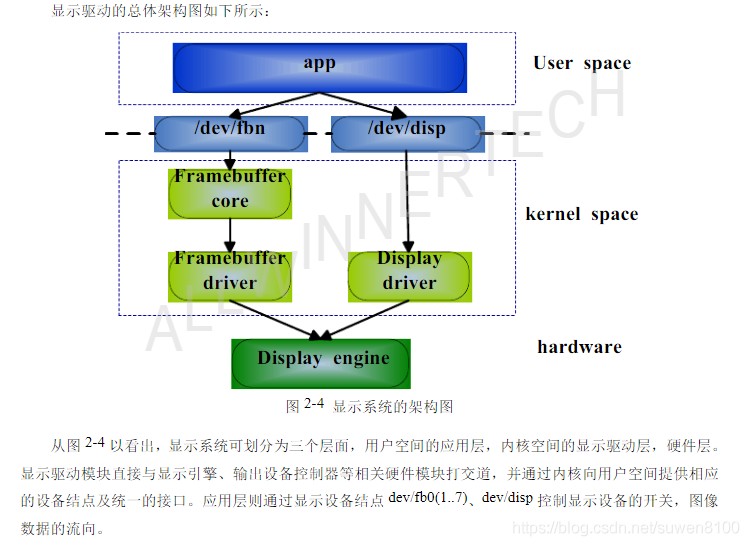
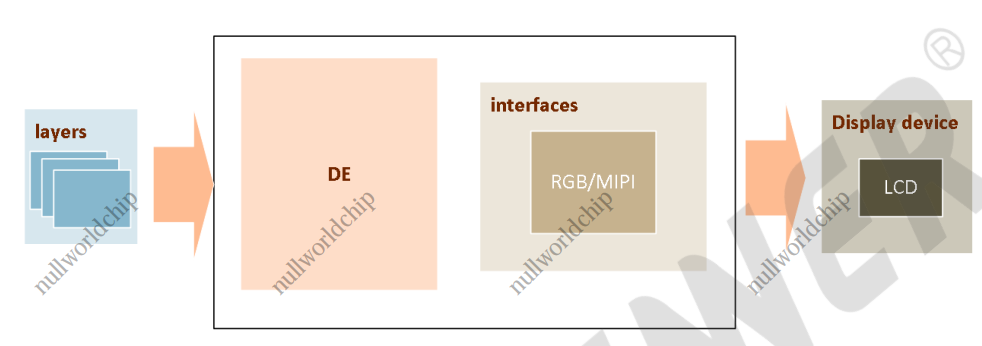
1、硬件术语
1)layer:一个图层处理单元,可以处理一张输入图像,按支持的图像格式分为video和ui类型。
2)channel:一个硬件通道,包含若干个图层处理单元,可以同时处理若干(典型4个)格式相同的图层。
3)alpha:透明度,在混合时决定对应图像的透明度。
4)transform:图像变换,如平移、旋转等。
5)overlay:图像叠加,按顺序将图像叠加一起的效果。Z序大的靠近观察者,会把z序小的挡住。
6)blending:图像混合,按alpha比例将图像合成一起的效果。
7)enhance:图像增强,有目的地处理图像数据已达到改善图像效果的过程或方法。
8)capture:截屏,将de的输出保存到本地文件。
9)de:Display Engine,显示引擎用于实现对图层的管理以及显示工作,支持HDMI、TV、LCD、等输出模式,是负责将输入的多图层进行叠加、混合、缩放等处理的硬件模块。它不但支持linux标准的framebuffer接口,还支持多种显示效果处理,比如alpha,colorkey,图像增强,亮度、对比度、饱和度、色度调整。
2、软件术语
1)fb:帧缓冲(framebuffer),linux为显示设备提供的一个接口,把显存抽象成的一种设备。(也可以通过ion分配buffer使用)
2)al:抽象层,驱动中将底层硬件抽象成固定业务逻辑的软件层。
3)lowlevel:底层,直接操作硬件寄存器的软件层。
二、Sunxi平台DE引擎
不同的处理器中的DE模块支持的功能具有差异,典型的DE模块支持1路显示通路,该显示通路支持4个可以做alpha blending操作的通道(channel),通道之间的排序可以通过Z值控制,Z值越大越靠上。每个通道又支持4个可以做overlay操作的图层(layer)。但是这四个显示通路并不完全一致,通道0和通道1称为Video channel,支持YUV和RGB数据格式的输入:通道2和通道3称为UI channel,仅支持RGB数据格式的输入。
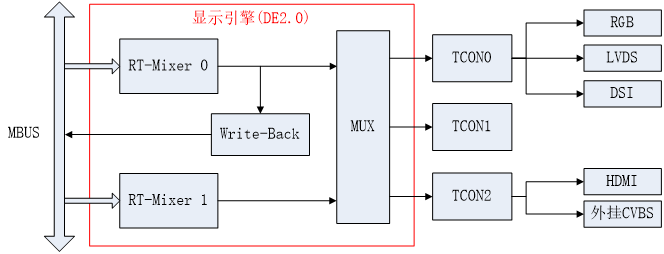

DE图层模块使用主要通过 ioctl 实现,对应的驱动节点是/dev/disp,具体定义请仔细阅读头文件上面的注释: kernel/linux-4.9/include/video/sunxi_display2.h。对于显示模块来说,把图层参数设置到驱动让显示器显示为最重要。以下介绍sunxi_display2.h中3个核心的结构体:
1) struct disp_layer_config2 : 该结构体包含对应通道和图层的全部信息
/* disp_layer_config2 - layer config v2
*
* @info: layer info
* @enable: indicate to enable/disable the layer
* @channel: the channel index of the layer, 0~max-channel-number
* @layer_id: the layer index of the layer widthin it's channel
*/
struct disp_layer_config2 {
struct disp_layer_info2 info;
bool enable;
unsigned int channel;
unsigned int layer_id;
};
sunxi 平台的 DE 接受用户设置的图层以 disp,channel,layer id 三个索引唯一确定 (disp:0/1,channel: 0/1/2/3,layer id:0/1/2/3),其中 disp 表示显示器索引,channel 表示通道索引,layer id 表示通道内的图层索引。
2)struct disp_fb_info2 : 该结构体对应图像缓冲区的信息
/* disp_fb_info2 - image buffer info v2
*
* @fd: dma_buf fd for frame buffer
* @size: size for each buffer, unit:pixels
* @align: align for each buffer, unit:bytes
* @format: pixel format
* @color_space: color space
* @trd_right_fd: dma_buf fd for the right-eye frame buffer,
* valid when frame-packing 3d buffer input
* @pre_multiply: indicate the pixel use premultiplied alpha
* @crop: crop rectangle for buffer to be display
* @flag: indicate stereo/non-stereo buffer
* @scan: indicate interleave/progressive scan type, and the scan order
* @depth: depth perception for stereo image, only valid when stereo image input
* unit: pixel
* @fbd_en: indicate if enable fbd function
* @metadata_fd: dma_buf fd for the buffer contained metadata for fbc/hdr
* @metadata_size: the size of metadata buffer, unit:bytes
* @metadata_flag: the flag to indicate the type of metadata buffer
* 0 : no metadata
* 1 <<0: hdr static metadata
* 1 <<1: hdr dynamic metadata
* 1 <<4: frame buffer compress(fbc) metadata
* x : all type could be "or" together
*/
struct disp_fb_info2 {
int fd;
struct disp_rectsz size[3];
unsigned int align[3];
enum disp_pixel_format format;
enum disp_color_space color_space;
int trd_right_fd;
bool pre_multiply;
struct disp_rect64 crop;
enum disp_buffer_flags flags;
enum disp_scan_flags scan;
enum disp_eotf eotf;
int depth;
unsigned int fbd_en;
int metadata_fd;
unsigned int metadata_size;
unsigned int metadata_flag;
};
Size 表示 buffer 的完整尺寸,crop 则表示 buffer 中需要显示裁减区。如下图所示,完整的图像以size 标识,而矩形框住的部分为裁减区,以 crop 标识,在屏幕上只能看到 crop 标识的部分,其余部分是隐藏的,不能在屏幕上显示出来。
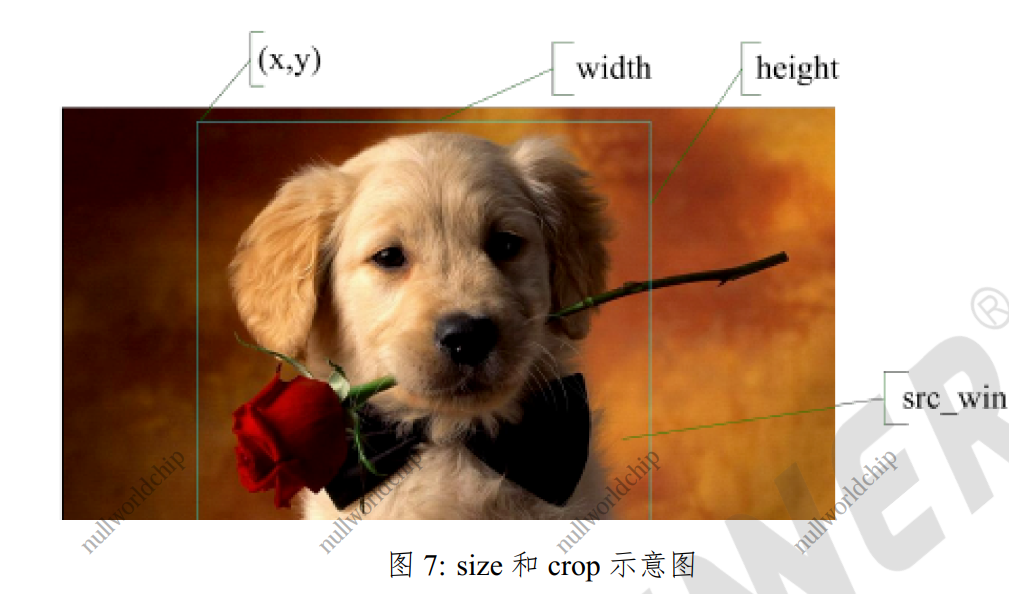
crop 上面已经介绍过,Screen win 为 crop 部分 buffer 在屏幕上显示的位置。如果不需要进行缩放的话,crop 和 screen win 的 width,height 是相等的,如果需要缩放,crop 和 screen win 的 width,height可以不相等
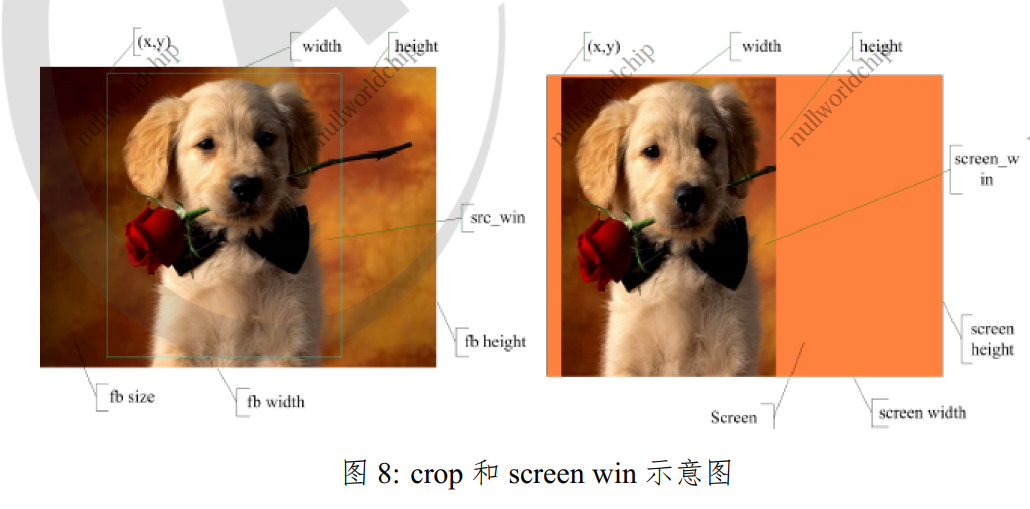
3)struct disp_fb_info2 : 该结构体对应图层的参数
/* disp_layer_info2 - layer info v2
*
* @mode: buffer/clolor mode, when in color mode, the layer is widthout buffer
* @zorder: the zorder of layer, 0~max-layer-number
* @alpha_mode:
* 0: pixel alpha;
* 1: global alpha
* 2: mixed alpha, compositing width pixel alpha before global alpha
* @alpha_value: global alpha value, valid when alpha_mode is not pixel alpha
* @screen_win: the rectangle on the screen for fb to be display
* @b_trd_out: indicate if 3d display output
* @out_trd_mode: 3d output mode, valid when b_trd_out is true
* @color: the color value to be display, valid when layer is in color mode
* @fb: the framebuffer info related width the layer, valid when in buffer mode
* @id: frame id, the user could get the frame-id display currently by
* DISP_LAYER_GET_FRAME_ID ioctl
* @atw: asynchronous time wrap information
*/
struct disp_layer_info2 {
enum disp_layer_mode mode;
unsigned char zorder;
unsigned char alpha_mode;
unsigned char alpha_value;
struct disp_rect screen_win;
bool b_trd_out;
enum disp_3d_out_mode out_trd_mode;
union {
unsigned int color;
struct disp_fb_info2 fb;
};
unsigned int id;
struct disp_atw_info atw;
enum disp_transform transform;
struct disp_snr_info snr;
};
Alpha 模式有三种:
0:Pixelalpha: 点alpha,即每个像素都有自己单独的 alpha,可以实现部分区域全透,部分区域半透,部分区域不透的效果。
1:Gloabal alpha: 全局alpha,也叫面alpha,即整个图层共用一个 alpha,统一的透明度。
2:Global pixel alpha: 可以是说以上两种效果的叠加,在实现 pxiel alpha 的效果的同时,还可以做淡入浅出的效果。

三、DE图层操作demo
sunxi显示驱动对应的字符设备节点为 /dev/disp ,驱动代码位置:kernel/linux-4.9/drivers/video/fbdev/sunxi/disp2/disp/dev_disp.c
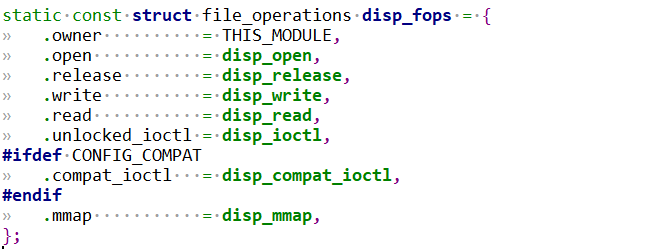
实际上只有disp_ioctl()和disp_mmap()两个函数有具体实现。
下面基于手上的A133平台通disp驱动添加一个图层,用于应用层直接写入ARGB数据进行显示。
首先查看当前设备的图层信息:cat /sys/class/disp/disp/attr/sys

其中 enable ch[0] lyr[0] z[0] 可以看出只有1个图层,即channel为0,layer为0,zorder(图层优先级,值越大越在上层)为0。
初始化部分代码:
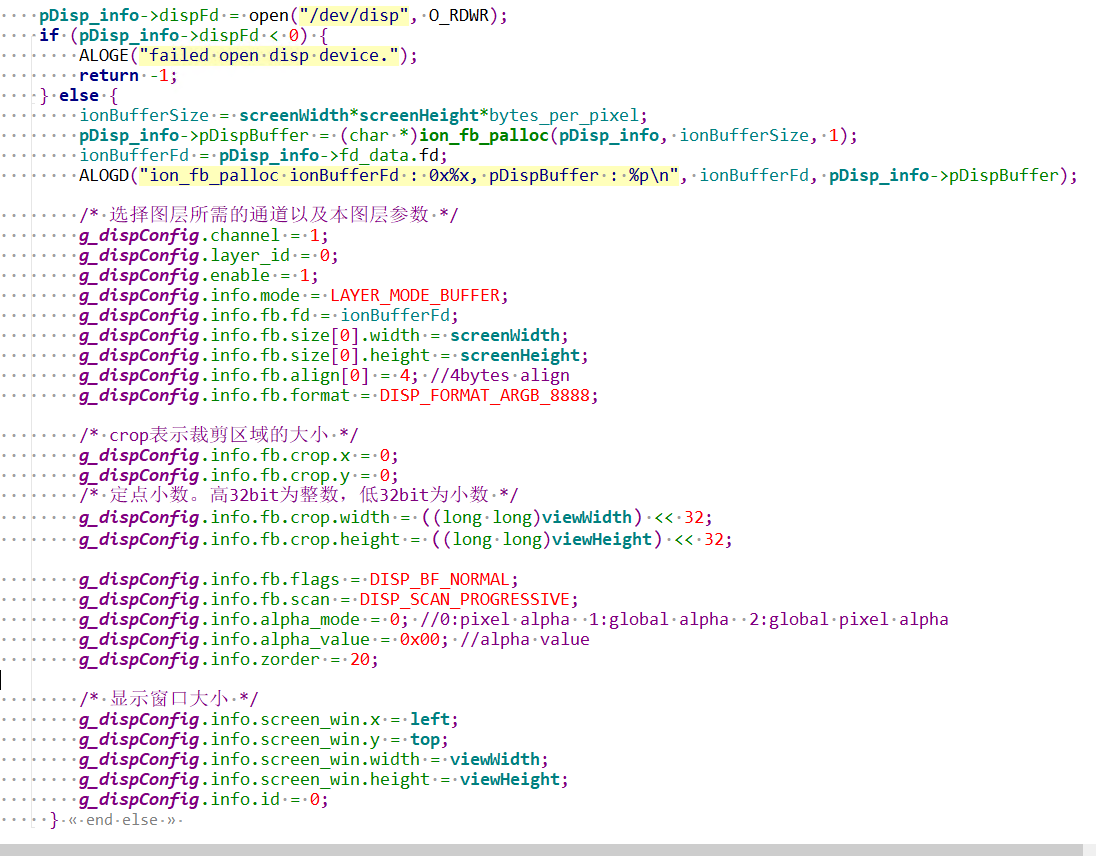
g_dispConfig就是struct disp_layer_config2变量保存当前的配置信息,然后通过ioctl发送到驱动层执行:

然后再查看设备的图层信息:

可以看出增加了一个图层:channel为1,layer为0,zorder为20(高于原来的图层ch[0])。
注:增加的图层不一定要对接到底层实际的framebuffer,可以通过ION驱动ION_IOC_ALLOC和ION_IOC_SHARE创建一块内存,然后通过共享内存的句柄mmap出虚拟地址给应用层直接写入数据进行显示,如上配置代码段中的g_dispConfig.info.fb.fd赋值的ionBufferFd就是ION Buffer的句柄。